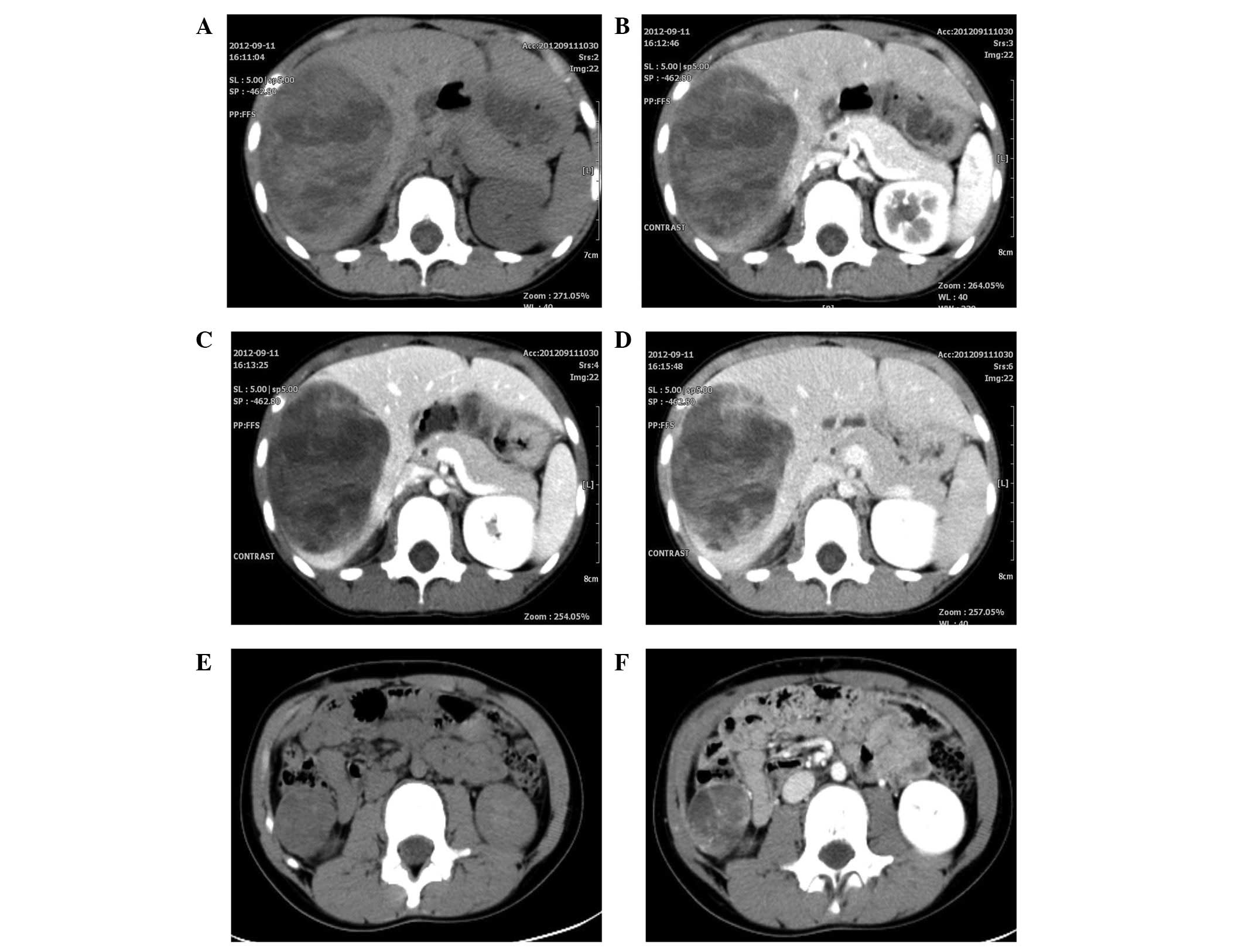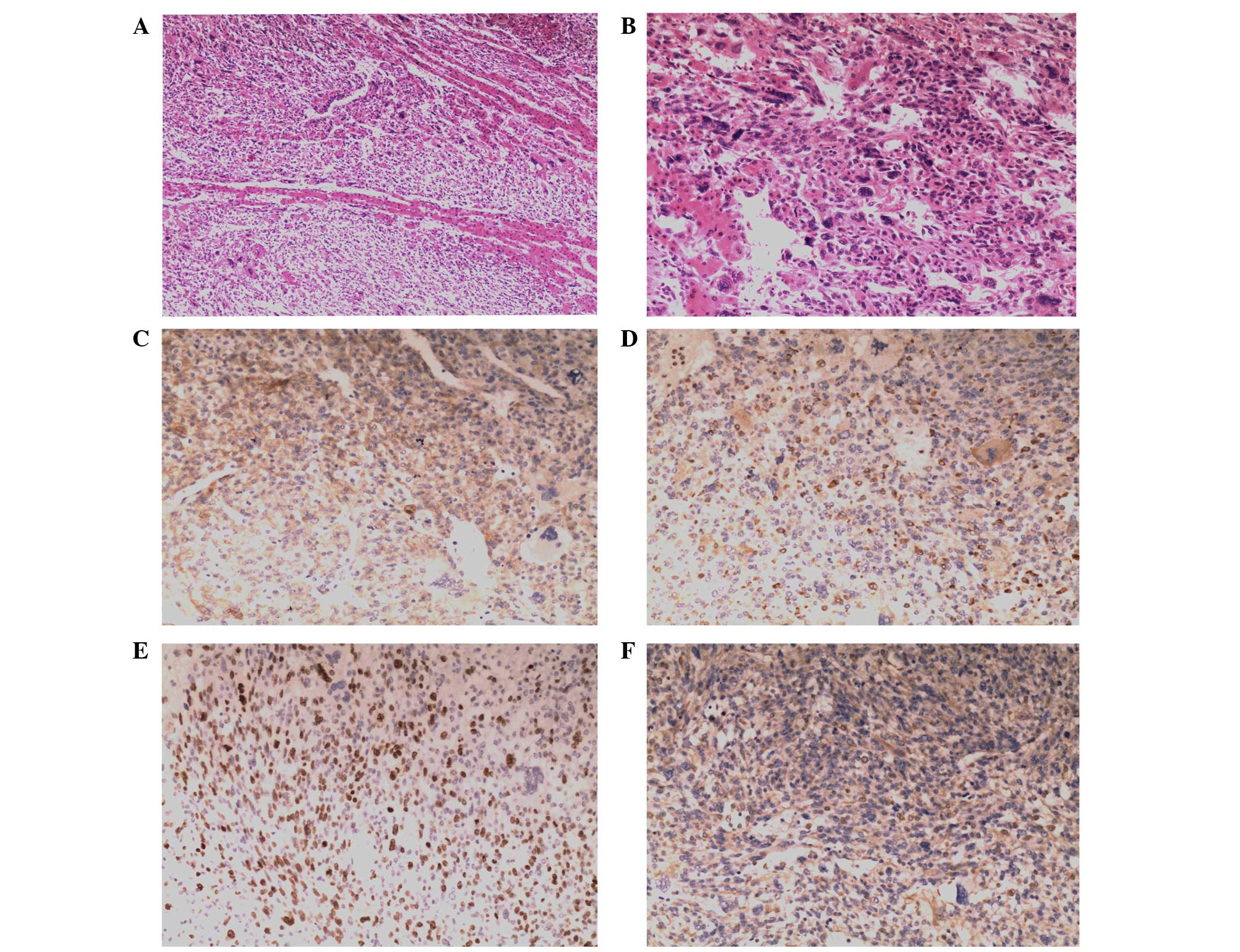Undifferentiated embryonal liver sarcoma in childhood: A case report
- Authors:
- Published online on: June 18, 2014 https://doi.org/10.3892/ol.2014.2262
- Pages: 1127-1132
Abstract
Introduction
Undifferentiated embryonal liver sarcoma (UELS) is a rare and highly malignant hepatic tumor of mesenchymal origin, which often occurs in individuals between 5 and 10 years old, as well as in young adults (1–3). Patients with UELS usually present with a painful right upper quadrant mass, fever and other symptoms, including weight loss, vomiting, nausea, anorexia and jaundice (4–6). Ultrasonography (US), computed tomography (CT), magnetic resonance imaging (MRI) and biopsy are used as diagnostic tools to identify other liver tumors. However, the typical radiological findings of liver tumors are also observed in other liver diseases, including cystic hydatid disease (5). Previous studies have shown that complete tumor resection followed by adjuvant chemotherapy and/or radiation improves survival and reduces recurrence in patients with UELS, and this has now become a current standard therapy for UELS (7–9). The present study presents a childhood case of recurrent UELS that was treated with surgical resection without chemotherapy, and discusses the clinical characteristics, laboratory test results, immunohistochemical findings and treatment for this rare disease. Written informed consent was obtained from the parents of the patient.
Case report
Clinical characteristics, laboratory findings and imaging
A 9-year-old, previously healthy female was admitted to The First Affiliated Hospital of Wenzhou Medical University (Wenzhou, China), and presented with abdominal pain and fever. Upon examination, the patient’s temperature was 38°C, the pulse was 86 beats per minute, the blood pressure was 103/53 mmHg and the respiratory rate was 20 breaths per minute. Abdominal tenderness was identified in the right upper quadrant without rebound tenderness. The remainder of the examination was normal and the results are shown in Table I. Abdominal CT scan revealed a cystic and solid mass with a size of 11.5×8.3×6.7 cm3 and a well-defined border, which involved the right lobe of the liver and had a non-homogeneous density (Fig. 1A). The density was marginally and heterogeneously increased in the enhanced CT scan (Fig. 1B–D). The clinical impression was that this mass represented a hepatoblastoma.
Treatment
Surgery was performed to resect the tumor. A right subcostal incision was made and, following entry into the abdomen, the ligamentum teres hepatis and falciform were incised. Examination of the future liver remnant and abdominal cavity revealed no evidence of tumor metastasis. The tumor had ruptured at the diaphragmatic surface and had adhered to the diaphragm. The surgical margin distance from the tumor was at ≥1 cm. The tumor was resected following the margins, until it was completely removed. A drainage tube was inserted under the right diaphragm and exited the body through the right abdominal wall. The abdominal wall was closed using standard procedures. During surgery, the patient had 300 ml bleeding and was transfused with 1.5 units of red blood cells.
Pathologic findings
Histological examination revealed pleomorphically shaped tumor cells with marked nuclei and clear to the eosinophilic cytoplasm (Fig. 2A–B). All the primary antibodies used in the present study are shown in Table II. Immunohistochemical staining of the tumor cells showed positive expression of caldesmon (Fig. 2C), cluster of differentiation (CD) 68 (Fig. 2D), Ki67 (Fig. 2E) and vimentin (Fig. 2F), but negative expression of α-fetoprotein (AFP), creatine kinase (CK), desmin, hepatocyte, muscle specific actin (MSA), myogenic differentiation (myod) 1, myoglobin and smooth muscle actin (SMA). On the basis of these findings, the patient was diagnosed with UESL, which was confirmed by two surgical pathologists.
Clinical course
The patient was recommended for further treatment, which was refused due to socioeconomic and psychological reasons. Thus, adjuvant chemotherapy was not initiated. Following complete tumor resection, the patient was regularly examined. Abdominal CT scans and US were performed every 3 months to monitor tumor recurrence. At the 6-month follow-up, the patient was surviving free of disease; however, at the 9-month follow-up, unenhanced CT revealed a right, low-density prerenal recurrent mass with a size of ~2.7×2.4 cm2 and a well-defined border (Fig. 1E). Enhanced CT showed a marginally and heterogeneously increased density (Fig. 1F). The patient did not accept any further treatment. Two months later, CT scan demonstrated that the mass had enlarged to ~3.3×3.4 cm2. A right prerenal dissemination of UESL was suspected. Based on the patient’s condition, a second surgical procedure was required.
Upon second admission, the patient was comfortable and physical examination revealed there was no abnormal condition. The laboratory results are shown in Table I. Complete prerenal tumor resection was performed. There was tumor hemorrhage inside. Microscopic analysis showed that the tumor was evidence of undifferentiated embryonal sarcoma recurrence. However, the patient was comfortable and physical examination revealed no abnormal conditions. In addition, the laboratory results were normal. Abdominal computed tomography scan and ultrasound were performed every 3 months to monitor the tumor recurrence. At the time of writing, it has been 6 months after the second surgical procedure and there has been no appearence of abnormalities.
Discussion
UELS is a rare, aggressive neoplasm with a poor prognosis, which predominantly affects children without gender predilection (1). UELS normally occurs in childhood, but has also been reported in adults (7). UELS typically presents with various non-specific tumor-associated symptoms, including right upper abdominal pain, distention, mass, nausea, swelling, vomiting, fever, weight loss, fatigue and jaundice (3,10,11). Occasionally, patients also have shoulder pain (10,12). Furthermore, physical examination occasionally reveals right upper abdominal tenderness. Laboratory studies are non-specific and have identified that patients with UELS exhibit low albumin, elevated lactic dehydrogenase, anemia and abnormal liver function (4,13,14). Moreover, serum assays for tumor markers, including AFP, cancer antigen 199 and carcinoembryonic antigen yield normal results.
The typical radiological finding of UELS is a large mass in the right liver lobe and occasionally in the left liver lobe. Abdominal CT images show large (range, 10–30 cm in size), cystic, solitary and well-circumscribed masses with variable areas of necrosis and hemorrhage (15,16). On enhanced CT, during the phase of the filling of the hepatic portal vein, a tumor was observed (15). Abdominal US reveals large multilocular (17) or unilocular (18) cystic and solid liver masses. The cystic region exhibits a large, mixed and disorderly low level echo (3,19), and the solid areas of the mass demonstrate a mixture of high and low level echos (19). Fluorine-18 fluorodeoxyglucose positron emission tomography (F-18 FDG PET)/CT may become increasingly important for the examination and treatment of UELS. F-18 FDG PET/CT may be a feasible and valuable imaging modality for further analysis of distant metastasis, as UELS and its metastases have strong F-18 FDG uptake (20).
Microscopically, UELS is characterized by cellular proliferation of oval, spindle or stellate pleomorphic cells with poorly defined cell borders (2,3). Immunocytochemically, the indices of the present patient were as follows: Caldesmon(+), CD68(+), Ki67(+), vimentin(+), AFP(−), CK(−), desmin(−), hepatocyte(−), MSA(−), myod1(−), myoglobin(−) and SMA(−). The outcome was approximately the same as that described previously (2). As in the present case, certain cases of UELS are positive for CD68 (21,22) and vimentin (23), which implies a mesenchymal origin. Moreover, in the present case, positive expression was found for caldesmon (24–26), which suggests sarcous origin. The positive expression of the proliferation marker Ki67 suggests it is an aggressive tumor (27,28).
The prognosis of UELS is poor even if the tumor is completely resected. Previous reports have demonstrated that treatment with surgery and adjuvant chemotherapy is curative for UELS in certain cases (1,9,29). May et al (4) reported five pediatric patients with UELS who were treated with radical resection followed by adjuvant chemotherapy or radiation and were alive without evidence of recurrence at a median of 53 months (4). Kim et al (9) reported that five pediatric patients who received similar therapy had a comparable prognosis, and proposed that a combined therapy of surgery and chemotherapy improves prognosis (9). Liver transplantation may be a potential treatment option for pediatric patients with UELS if it is feasible. Liver transplantation has been reported in pediatric patients with UELS (12,30,31). One study reported the case of a 6-year-old male who received a liver transplant combined with chemotherapy and was alive 6.5 years following surgery (30). Furthermore, another study reported a male who has been in good health and disease-free for 5 years following treatment with chemotherapy, surgical resection and liver transplantation (12). However, reports of liver transplantation to treat UELS are limited.
In conclusion, complete tumor resection combined with adjuvant chemotherapy may reduce the risk of recurrence and improve the survival time in patients with UELS. Further investigations are required to identify more effective strategies for treating pediatric patients with UELS.











